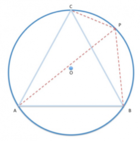[math]ABC[/math]
e la circonferenza ad esso circoscritta. Tracciate due altezze del triangolo [math]BM[/math]
e [math]CN[/math]
, esse vengono prolungate fino ad intersecare la circonferenza in due punti [math]P[/math]
e [math]Q[/math]
. Se [math]BC[/math]
misura [math]5[/math]
. e [math]PQ[/math]
misura [math]6[/math]
, quanto misura il raggio della circonferenza? Poniamo
[math]\hat{BAC}=\hat{BPC}=a[/math]
Poiché gli angoli in M ed N sono retti (per ipotesi sono i piedi delle altezze) ne segue che:
[math]\hat{NCA}=\hat{MCP}=\frac{\pi}{2-a}[/math]
Per il teorema della corda, applicato ai triangoli
[math]PQC[/math]
ed [math]ABC[/math]
,si ha:[math]PQ=2R \cdot \sin (180°-2a)=2R \cdot \sin(2a)=4R \cdot \sin(a)\cos(a)[/math]
[math]BC=2R \cdot \sin (a)[/math]
(1)Dividendo membro a membro risulta :
[math]6/5=2\cos(a)[/math]
da cui [math]\cos(a)=3/5[/math]
Pertanto :
[math]\sin a=\sqrt{1-9/(25)}=4/5[/math]
e quindi sostituendo nella (1):[math]5=2R \cdot 4/5[/math]
da cui [math]R=(25)/8[/math]
FINE




